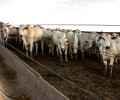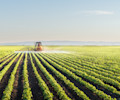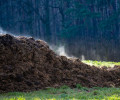During digestion, cattle emit methane, which has a major impact on greenhouse gas emissions. The negative effect of methane on the environment has been found to be 23 times more than the effect of CO2. The average cow releases between 70 and 120 kg of methane per year. In addition, ammonia and particulate matter emitted from farms can cause respiratory health problems in farm workers and local communities.
Types of air pollution
Gas emissions and fumes
The livestock industry is choking the earth, responsible for 14.5% of all greenhouse gas emissions. Farming livestock contributes around 6 billion tonnes of greenhouse gases (carbon dioxide, methane and nitrous oxide) to the atmosphere each year. As well, waste lagoons emit considerable ammonia emissions from rotting waste and fertiliser.
Odour
Foul odours from the concentration of animal waste is unpleasant for nearby residents. Waste lagoons and the use of manure as fertilizer for crops generates undesirable odours for local communities. Smithfield Foods, a US subsidiary of Chinese pork producer WH Group, is facing over 20 nuisance suits brought by local communities, complaining of bad odour and noise pollution. The company has lost all five suits that have been heard to date, as of May 2019.
Causes of air pollution
Poor waste management
Over application of animal waste to land and manure storage in open lagoons emits harmful greenhouse gases into the atmosphere. In the US, animal waste contributes 50 to 85% of ammonia emissions. When in the air, ammonia is regarded as a powerful pollutant because of its capacity to combine with other pollutants in the atmosphere to create small, solid particulate matter pollution. These are highly harmful to the lungs and respiratory system when inhaled and are known to exacerbate respiratory problems.












